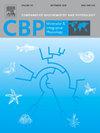Water pH alters acid-base compensatory responses in white sturgeon (Acipenser transmontanus) exposed to modest and severe environmental hypercapnia
IF 2.2
3区 生物学
Q4 BIOCHEMISTRY & MOLECULAR BIOLOGY
Comparative Biochemistry and Physiology A-Molecular & Integrative Physiology
Pub Date : 2025-06-26
DOI:10.1016/j.cbpa.2025.111900
引用次数: 0
Abstract
Elevated CO2 (hypercapnia) in fishes induces a respiratory acidosis, which is compensated by branchial acid-base relevant ion transfer. This organismal compensation is hypothesized to be affected by water pH, but assessing this effect is difficult when examining fish species (e.g., rainbow trout Oncorhynchus mykiss, Japanese flounder, Paralichthys olivaceus) that rely on extracellular pH regulation (pHe) to drive recovery as when it fails, mortality may occur quickly. Examining fishes that both perform pHe compensation, but do not require it for survival due to preferential intracellular pH (pHi) regulation (PPR) such as does the white sturgeon (Acipenser transmontanus), allows us to determine the effect of water pH on acid-base compensation during hypercapnia. White sturgeon were exposed to 48 h of elevated CO2 tensions while manipulating water pH to determine how water pH can alter patterns of acid-base compensation. Our findings demonstrate that water pH manipulation can have significant effects on the pHe compensatory response. For example, complete pHe compensation was observed in fish exposed to water equilibrated with 1 kPa CO2, but reducing water pH by ∼1 pH unit prevented complete compensation. Alternately, when sturgeon were exposed to alkalized water equilibrated with 4 kPa CO2 (i.e., pH of 6.3 compared to 5.7 for water with 4 kPa CO2), pH compensation was more rapid. Water pH and pHe compensation rates had no effect on pHi regulation. Our findings demonstrate that water pH can aid or assist pHe compensatory rates at a range of hypercapnic challenges, and so may have contributed to the origin of PPR as a primary strategy for some fish species to protect critical tissues largely independent of environmental conditions.
Summary
White sturgeon were exposed to two levels of elevated CO2 (1 and 4 kPa) in water of two different pH values, and we tracked pH compensatory responses over the following two days. Acidifying water at modest CO2 levels within the limit for complete compensation reduced the rate at which blood pH recovered. Alkalizing water during severe hypercapnia typically beyond that limit increased both the magnitude and the rate of organismal pH compensation. Intracellular pH protection was unaffected by any treatment.
水的pH值改变了暴露于中度和重度环境高碳酸血症的白鲟的酸碱补偿反应
鱼类体内二氧化碳浓度升高(高碳酸血症)可引起呼吸性酸中毒,并通过鳃酸碱相关离子转移进行补偿。这种有机体补偿被假设受到水pH值的影响,但在检查依赖细胞外pH调节(pHe)驱动恢复的鱼类(例如虹鳟鱼Oncorhynchus mykiss,日本比目鱼,olivaceus)时,评估这种影响是困难的,因为当它失败时,死亡可能很快发生。研究那些既进行pHe补偿,但由于细胞内pH (pHi)优先调节(PPR)而不需要它来生存的鱼类,如白鲟(Acipenser transmontanus),使我们能够确定高碳酸血症期间水pH对酸碱补偿的影响。研究人员将白鲟暴露在48小时二氧化碳浓度升高的环境中,同时控制水的pH值,以确定水的pH值如何改变酸碱补偿模式。我们的研究结果表明,水的pH值操纵可以对pHe代偿反应产生显着影响。例如,在暴露于1千帕二氧化碳平衡的水中的鱼中观察到完全的pHe补偿,但将水的pH降低约1个pH单位会阻止完全补偿。另外,当鲟鱼暴露在4千帕二氧化碳平衡的碱化水中(即pH为6.3,而4千帕二氧化碳平衡的水为5.7),pH补偿更快。水pH和pHe补偿率对pHi调节无影响。我们的研究结果表明,在一系列高碳酸血症挑战中,水的pH值可以帮助或辅助pHe补偿率,因此可能有助于PPR的起源,作为一些鱼类在很大程度上独立于环境条件保护关键组织的主要策略。将白鲟暴露在两种不同pH值的水中,浓度分别为1和4千帕,我们在接下来的两天里跟踪了它们的pH补偿反应。在完全补偿的限度内,以适度的二氧化碳水平酸化水,降低了血液pH值恢复的速度。在严重的高碳酸血症期间,碱化水通常超过该极限,增加了有机pH补偿的幅度和速率。细胞内pH保护不受任何处理的影响。
本文章由计算机程序翻译,如有差异,请以英文原文为准。
求助全文
约1分钟内获得全文
求助全文
来源期刊
CiteScore
5.00
自引率
4.30%
发文量
155
审稿时长
3 months
期刊介绍:
Part A: Molecular & Integrative Physiology of Comparative Biochemistry and Physiology. This journal covers molecular, cellular, integrative, and ecological physiology. Topics include bioenergetics, circulation, development, excretion, ion regulation, endocrinology, neurobiology, nutrition, respiration, and thermal biology. Study on regulatory mechanisms at any level of organization such as signal transduction and cellular interaction and control of behavior are also published.

 求助内容:
求助内容: 应助结果提醒方式:
应助结果提醒方式:


